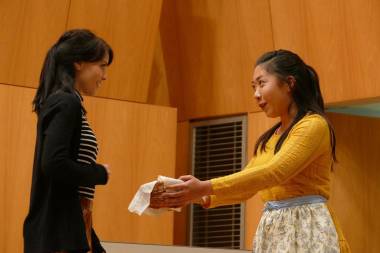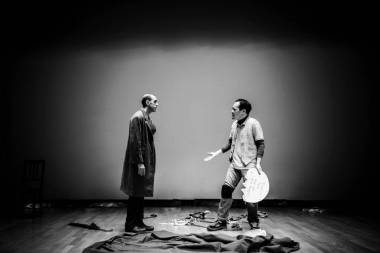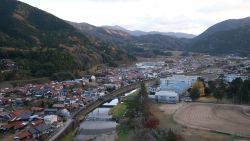
December 9, 2016
Behind the Curtain
How the Tokyo International Players play the theatre game
By Angela Qian

According to Saya Suetsugu, the Tokyo International Players originally started as a hobby for bored expat housewives. “They had the money to spend and there wasn’t anything else that they wanted to do but to be involved in doing arts,” she says. That was 120 years ago. Since then, the Tokyo International Players has expanded and evolved into one of the most recognizable English-language theater organizations in the Tokyo arts community.
Suetsugu is the current president of the TIP board. Talking to her and to several other members of the TIP community, I got the impression of a wide web of the various players that make TIP possible—the actors, writers, backstage managers, costume designers, front-of-house volunteers and publicists. Most of all, the picture drawn for me was one of intense energy: of unrelenting activity from these people whose lives revolve around their devotion to theater and the creative arts.
Renaissance Men & Women
It’s hard to find a single TIP member without a dozen other interests. For instance, Brian Berdanier, vice president of the board of directors, comes from a background in classical voice, linguistics, acting and literature. His day job is teaching at an international high school, and as the TIP literary manager, he is usually reading half a dozen scripts at any given time. “He’s a dramaturg, director, actor, French teacher…” Kimie Mizuno, director of the next Main Stage production Speaking in Tongues, says admiringly.
Jack Merluzzi, TIP’s technical adviser, worked in radio for seventeen years and handles sound mixing and lights for TIP. He’s also employed as a character voice artist. Sara Ben-Aballah, the TIP costumer, has also worked in glassworking, woodworking, and welding. “I love making stuff with my hands,” she tells me; “I made all my furniture in university.”

Rodger Sono works at the Asahi Shinbun by day; by night, he’s an actor and videographer active in the Tokyo International Players and at least three other theater groups, as well as two improv comedy groups. He even writes his own plays and draws comics. I am told by another TIP member that Rodger is an accomplished cook and baker, and leads group hikes to forage for and cook wild ingredients. I interviewed him on a Friday; when I asked when he’d last slept, he said, “Tuesday.” It’s a joke—I think.
Heavenly Spheres (of Influence)
Though each TIP member I spoke with mentioned how inspiring the other members are, each member also has their own particularly beloved artists. “More than theater, I think I’m more inspired by art,” Mizuno says, citing Yayoi Kusama and Yoko Ono. She also talks about her mother, Yoshie Mizuno, a full-time Australian artist who had done exhibitions in Indonesia and America. “I think seeing that, I was like, oh it’s cool, you can be an artist. You’re not a deadbeat, you’re trying to do art,” Mizuno says.
TIP also bleeds into several other theatre projects around Tokyo, such as the Black Stripe Theater or the Tokyo Artistic Theatre Ensemble. Suetsugu, Sono, and several other TIP players will be involved this year with the Tokyo Theatre for Children, which puts on playful performances that introduce young children to the creative field. TIP interests have also intertwined with other professional and personal opportunities; Sono tells me about Impro5, an English improv team which takes on a Japanese improv team in workshops that teach English to companies such as Dentsu. Ben-Abdullah runs her own online boutique, Kinu Outfitters, which sells custom-made items created from vintage kimonos. She also describes how she met her now-husband after designing his costume for the role “torture victim man”—a very romantic first encounter, she says dryly.
Post-Show Blues
The amount of work that goes into TIP is immense; a director may start planning for a show years in advance, and once it’s approved, it’s a marathon lasting as long as six months. “People are like, ‘Oh, you’re a community theater group, it’s just amateur drama,’” Suetsugu says, “and then they come to the show and they’re like, ‘Oh, I was not expecting it to be that good.’”
This dedication easily lends itself to significant, even symbolic memories. Merluzzi describes a moment in The Rocky Horror Show when everything builds to a huge entrance—the lights falling to reveal Dr. Frank N. Furter in silhouette, wearing 4-inch heels and a wing-like cape. “The audience paused for a half second to take it all in and then burst into applause… for over forty seconds!” he says. Ben-Abdullah describes the same moment. She was backstage, and hearing the applause was so moving that she cried.
The high of putting a production into play can be intense. “You don’t really realize until after the show is finished,” Sono tells me, “but then after the show is finished and everyone is like otsukaresama and there’s a lull…and then you get off at the station for rehearsal [again.]’”
Mizuno has her own phrase for this: the post-show blues. “It’s very stressful, a lot of hard work, there are constantly things going wrong, but that’s the beauty of theater.”





